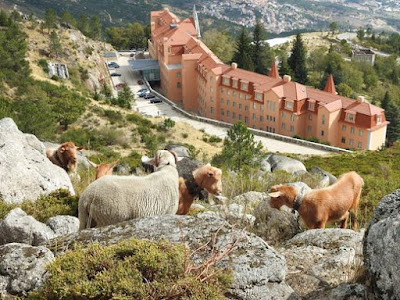TUBERCULOSIS
SANATORIUM
- PORTUGAL -
G'day folks,
Welcome to some panoramic views from the mountains over a facility built to provide tuberculosis patients with fresh mountain air.
At an altitude of 1,300 meters, this overlook offers a wide panoramic view over the southern half of the district of Guarda, the northernmost sectors of the district of Castelo Branco, and the western parts of the provinces of Salamanca and Cáceres in Spain.
A small tower is visible from the road—walk up to it and you might hear some goat bells clanging and see the shepherd on the tower with binoculars. He’s either birdwatching or on fire watch. The goats and sheep are rummaging around and you have a great view over the town of Covilha and the former Sanatório da Covilhã (Sanatorium of Covilha) just below. The sanatorium was built in the 1930s by the by the Companhia dos Caminhos de Ferro Portugueses (Portuguese Railways Company) as a treatment facility for tuberculosis patients. It was thought that the fresh mountain air of the Serra da Estrela would help them recover.
The facility was designed by the actor, director, and architect José Ângelo Cottinelli Telmo. He is famous for designing the Monument of Discoveries in Lisbon. Telmo planned the sanatorium as a great hotel in the mountains, a romantic idea that aimed to overcome the stigma associated with tuberculosis. It was built in a V-shape and designed to look like a train, according to the architect.
As medical advancements helped lessen the impact of tuberculosis, the need for sanatoriums fell off. Operation of the Sanatório da Covilhã was handed over to the government in the 1950s. By the end of the 1960s, the last remaining patients were gone, and the sanatorium was closed in 1970. For a time it was used as a refugee center for people returning from former Portuguese colonies. By the 1980s it was largely abandoned, and had fallen into disrepair. In the late 1990s it was turned into a pousada with spa facilities.






No comments:
Post a Comment